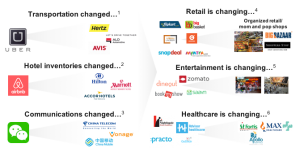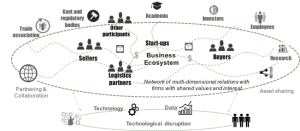Digital Reinvention
Enabling sustainable business growth: The age of digital ecosystems
December 6, 2017 | Written by: Parag Risbud
Categorized: Digital Reinvention
Share this post:
Enabling sustainable business growth: The age of digital ecosystems
By Parag Risbud, Digital Strategy, IBM
The world around us is changing and this change is influencing the way in which consumers lead their lives. Organizations are realizing that one cannot assume to be in control of the events or else it could be detrimental to their sustenance. Therefore, it is important for them to adapt to the changes happening in the business environment. In the age of globalization and fast paced change, the ability of organizations to leverage technologies to create new opportunities will drive sustainable growth.
Globally, new entrants are disrupting traditional enterprises across industries and India is not immune to this innovator led disruption, as can be seen from the picture below.

Source: IBM Institute of Business Value
We see traditional value chains being disintegrated or replaced, convergence of industries and we are also seeing the emergence of business ecosystems. An ecosystem can be thought of as a complex web of interdependent enterprises and relationships that creates business value and where the orchestrator and varied participants gain from the role they play.
The rise of ecosystems facilitated by digital technologies, where multiple enterprise partners across industries could possibly collaborate for better scale, increased scope and higher speed to market. According to an IBM C-suite study, 69% CEOs rate emergence of ecosystems as the most impactful trend.
Ecosystem illustration

Source: IBM Institute of Business Value
Traditional automotive ecosystem existed in which individual car manufacturers controlled their supply chains and distribution channels. Each manufacturer had its short to long term business contracts and in a way the car manufacturer orchestrated a closed ecosystem. Imagine a digital ecosystem having an autonomous city tourist bus or a van at its centre, which is a self-driving transportation 3D printed vehicle, and has its intelligence powered by a Cognitive engine, and the entire experience being designed and delivered using Interactive Experience and Cloud services. In this ecosystem, there is a capability around weather monitoring which provides updates to tourists about local restaurants and entertainment complexes for information and reservation etc.
Ecosystems are expanding capabilities and enabling experiences in healthcare and life sciences beyond anything possible today. Imagine a Healthcare ecosystem with Patients & Consumers as the focal point; patients are able to interact and collaborate effectively with Life sciences product & service providers, Public health services, Healthcare providers, Retail clinics, Pharmacies, Employers, Regulators, Transaction services. Such an ecosystem can co-create significant economic value, whilst maintaining the requisite privacy and security risks.
Innovative enterprises could articulate a vision to solve important customer problems and that too in most industries such as food and agriculture, chemicals and fertilizers, buildings, electricity and other sectors.
Consider the example of a rapidly growing traditional Home improvement ecosystem in India. This comprises a host of product, material and service providers.

One can imagine a value pyramid where the Architects & Interior designers provide high value design & management services, contractor provides execution support and at times design services and then there are décor products & various building material suppliers etc. making it a complex ecosystem with multiple stakeholders. What is also clear is that for most people home improvement is a challenge in India. Customer journeys are often long and complex with many barriers and constraints.
In all of the above examples, digital giants such as IBM could potentially play an important role in such ecosystems as an orchestrator or technology innovator.
The shift to business ecosystems requires a change in the people, processes and technologies that underpin the organization. An ecosystem creation initiative by an innovative enterprise could bring several key questions to the fore.
What is the motivation for orchestrating (or participating) in a digital ecosystem? Who is the target customer or customers? What is the value proposition? Who are the participants to collaborate with? What are the resources and capabilities required?
Key technology strategy elements which can help capitalize the business ecosystems opportunities and respond to threats are:
- Integrating digital platform development into technology and business strategic planning
- Recognizing the significance of application programming interfaces (APIs) which can open new business opportunities
- Focusing on Event-driven IT which could make the organization more innovative and accelerate its transformation into a digital business
- Building algorithmic business with embedded rules and business logic
An experienced team of Digital strategy practitioners can ably support organizations in conceiving and implementing a Digital ecosystem strategy.
Broadly the Strategy phase would comprise of four steps followed by implementation and change management:
- Define and finalize the customer persona, customer journey and the value proposition – ‘The Why’ of the Digital Ecosystem
- Articulate the digital business capability & processes to “delight / WOW” the target customer
- Define a future proof architecture to adopt a nimble & evolving ecosystem & data strategy
- Establishing the “Agile” and “Digital” way of working
Are you ready for Digital Reinvention? Contact IBM Digital SME Now!
The solutions practice draws on the expertise of more than 2,000 consulting professionals spanning machine learning, advanced analytics, and data science, all supported by specialists with deep industry understanding. Know more about IBM Digital capabilities

Digital Strategy Lead, IBM GBS I/SA
Logistics Operations Management ERP on AWS Cloud
Logistics operations is an essential part of the supply chain and refers to the process of moving finished goods, starting from the manufacturer, and moving to the end user.
How ICICI Prudential Life Insurance is Scaling Customer Care and Leveraging AI to Personalize Experiences
Organisations are constantly challenged to meet dynamic customer requirements and rethink ways to engage with them on their terms and as per their convenience. With customers at the core of decision making and business success, organisations are tuning to digital capabilities that can support new-age services. When done well, after sales service boosts the overall customer experience by providing […]
Genpact undergoes cyber defense transformation with IBM Security
Genpact, a global professional services firm, is accelerating digital-led innovation and digitally-enabled intelligent operations for its clients – many of them Global Fortune 500 companies – to deliver real-world transformation at scale. With oversees global operations in 30 countries serving over 800 clients, Genpact’s 90,000+ employees are reinventing business models and running thousands of processes, […]


